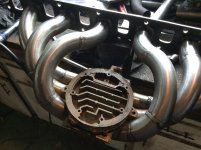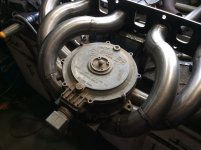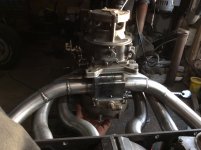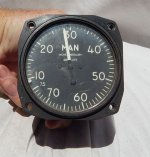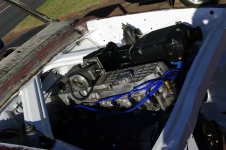Some time ago I wrote up a short speech about my readings and experiences of supercharging and propane fuel to present to my car club. Since its quiet here I thought I'd attach it for those who care to read it and chuckle:-.
Supercharging, what is it?
Supercharging is basicaly increasing the mass airflow of any given internal combustion engine.
This can be done in several different ways, using a compressor/pump is one way, and is the most common method.
So a natural aspirated engine will draw in the fuel air mixture under only atmospheric pressure, and even then the inefficiences of the engine usually wont allow the engine to fully utilise the cylinder volume it has, this is the volumetric efficiency, and is usually below 100%. sometimes as low as 50%
When we add a compressor or pump to the intake side of the engine we raise the intake pressure above atmospheric so that a higher VE is achieved and a larger mass of fuel air enters the engine, and therefore a higher cylinder pressure is achieved and torque is increased.
The method of compression/pumping used is influentual on the efficiency of the whole process, I will outline some of the methods and why I chose the one I used on my car.
Since we are trying to get a higher MASS flow into the engine, and this is determined by the pressure and temperature, we want the greatest compression with the least heat added to the air, this is called the adiabatic efficiency of the compressor/pump, and varies depending on the design of the compressor. For instance the older rootes type of blower seen on many engines is basicaly an air mover, it takes air into its casing, moves it by the rotors around to the outlet side where it enters the intake manifold and the engine. There is no compression in doing this, the pressure in the intake manifold is only raised because the blower is trying to move more air than the engine can displace, for instance if a blower moves 2litres of air per revolution, but the engine can only move 1 litre per rev, then the maths says the pressure will be raised to 2bar, assuming 1 bar is atmospheric pressure.
In the case of the rootes blower it unfortunately adds more heat to the air than would be added by the gas laws, its adiabatic efficiency is quite low, sometimes under 50%, this means of course the mass airflow is reduced and thus less torque.
There are other types of compressors, but in all cases there are some inefficiencys, for instance a centrifugal compressor, has a higher efficiency than the rootes but when driven by a turbine, the turbocharger, its looses efficiency here too, so overall only slightly better than the rootes, and here we have not mentioned the delay in increasing the manifold pressure usually experienced by this arrangement.
However a really well integrated turbo can work quite well, and most modern diesels are an example, however they still have a delay in producing boost. Volvo had used both types of supercharging at the same time, but it becomes very complicated.
Centrifugal compressors can be directly driven from the crankshaft by belts or gears and this has been done in the past, however we have a non linear boost curve, most of the raised pressure doesn’t come until very high revs are on board, early Novi Indy cars are an example.
.
Next we come to the screw type compressor, in this design we have two meshing rotors in a similar way to the rootes, however in this type we get internal compression with very high efficiency which only adds a small amount of heat to the air as its compressed, this compressor is widely used in industrial applications when large volumes of compressed air are required. These are harder to manufacture and require a high degree of accuracy to achieve success, its really only been the application of CNC machining that has allowed this type to enter the automotive market, they are still considered expensive.
In my car I decided this was the best unit for supercharging the engine I was to use, happily I was able to get one for a very good price. In my application the twin screw, or lysholm, to give credit to its designer, moves 1.1litres of mixture every revolution. I have driven this compressor at a ratio of 2.9:1, so its running almost 3 times crankshaft speed, thus it moves 3.3 litres per revolution, and since my engine is 3.3 litres in displacement, only half that every rev, in theory I should raise the manifold pressure by 2, giving 2 bar pressure. This has turned out to be slightly higher in practise.
I also wanted to run this engine on LPG, I knew that fuel consumption would be high, so felt that this low cost fuel would allow me to drive it without worrying about the cost. This has in fact been true. Also the LPG having a higher octane rating than any of the liquid fuels allows a higher compression ratio, and thus higher thermal efficiency. In this application I have run 9:1 CR, which is at least one ratio higher than I could run with petrol.
To make it all work I had to fabricate the intake manifold, blower drives, blower supports, its quite heavy, a blower bypass valve and GRA gas mixer inlet pipe, fitting this all into the XP was a bit of a task, but some nutting out got it done, I had read all the relavant texts and had some first had gas engine experience to call upon. There are very few supercharged LPG engine around so some things were experiemental.
So how did it all turn out? Very well in my opinion, the manifold pressured turned out to be a little higher than I had expected, usable torque is quite high around 450nm and available at any speed just by opening the throttle. Fuel consumption is high, but not quite as high as I thought it might be, around 23litres per 100km. LPG has allowed the engine to run very smoothly, it usually does, there is no problems with mixture formation as the gas is a perfect vapour when it enters the engine, unlike petrol.
Ignition timing was initially a problem, I had too much advance and consequent pinging at larger throttle openings, this has be resolved by fixing the spark advance. Lpg engines like a lot of advance at idle and low speeds, but less than a petrol engine as the rpm rises, I had added boost to the mix, and this was an unknown area for most people I asked, so fiddling around was the only way. At no time did I use a road wheel dyno to tune the engine, it was all done by the old seat of the pants method.
Detonation is often a problem with supercharged engines, but so far I have not heard any, I do get slight problems with belt slip, but Im using that as a manifold pressure limiter. I dont want to end up with sump full of pistons.
The 3.3 litre falcon six I have does not have any preparation for boost, and most of its internal parts are older used ones from second hand bits I found, I’m actually surprised they have held up so well. I get no problems with overheating. Overall I am very pleased with it. Compared to other high performance engines I have had, this one is by far the most easy to get along with, big cams carbies etc will get the power, but their behaviour is pretty bad, and fuel consumption is terrible.
Supercharging, what is it?
Supercharging is basicaly increasing the mass airflow of any given internal combustion engine.
This can be done in several different ways, using a compressor/pump is one way, and is the most common method.
So a natural aspirated engine will draw in the fuel air mixture under only atmospheric pressure, and even then the inefficiences of the engine usually wont allow the engine to fully utilise the cylinder volume it has, this is the volumetric efficiency, and is usually below 100%. sometimes as low as 50%
When we add a compressor or pump to the intake side of the engine we raise the intake pressure above atmospheric so that a higher VE is achieved and a larger mass of fuel air enters the engine, and therefore a higher cylinder pressure is achieved and torque is increased.
The method of compression/pumping used is influentual on the efficiency of the whole process, I will outline some of the methods and why I chose the one I used on my car.
Since we are trying to get a higher MASS flow into the engine, and this is determined by the pressure and temperature, we want the greatest compression with the least heat added to the air, this is called the adiabatic efficiency of the compressor/pump, and varies depending on the design of the compressor. For instance the older rootes type of blower seen on many engines is basicaly an air mover, it takes air into its casing, moves it by the rotors around to the outlet side where it enters the intake manifold and the engine. There is no compression in doing this, the pressure in the intake manifold is only raised because the blower is trying to move more air than the engine can displace, for instance if a blower moves 2litres of air per revolution, but the engine can only move 1 litre per rev, then the maths says the pressure will be raised to 2bar, assuming 1 bar is atmospheric pressure.
In the case of the rootes blower it unfortunately adds more heat to the air than would be added by the gas laws, its adiabatic efficiency is quite low, sometimes under 50%, this means of course the mass airflow is reduced and thus less torque.
There are other types of compressors, but in all cases there are some inefficiencys, for instance a centrifugal compressor, has a higher efficiency than the rootes but when driven by a turbine, the turbocharger, its looses efficiency here too, so overall only slightly better than the rootes, and here we have not mentioned the delay in increasing the manifold pressure usually experienced by this arrangement.
However a really well integrated turbo can work quite well, and most modern diesels are an example, however they still have a delay in producing boost. Volvo had used both types of supercharging at the same time, but it becomes very complicated.
Centrifugal compressors can be directly driven from the crankshaft by belts or gears and this has been done in the past, however we have a non linear boost curve, most of the raised pressure doesn’t come until very high revs are on board, early Novi Indy cars are an example.
.
Next we come to the screw type compressor, in this design we have two meshing rotors in a similar way to the rootes, however in this type we get internal compression with very high efficiency which only adds a small amount of heat to the air as its compressed, this compressor is widely used in industrial applications when large volumes of compressed air are required. These are harder to manufacture and require a high degree of accuracy to achieve success, its really only been the application of CNC machining that has allowed this type to enter the automotive market, they are still considered expensive.
In my car I decided this was the best unit for supercharging the engine I was to use, happily I was able to get one for a very good price. In my application the twin screw, or lysholm, to give credit to its designer, moves 1.1litres of mixture every revolution. I have driven this compressor at a ratio of 2.9:1, so its running almost 3 times crankshaft speed, thus it moves 3.3 litres per revolution, and since my engine is 3.3 litres in displacement, only half that every rev, in theory I should raise the manifold pressure by 2, giving 2 bar pressure. This has turned out to be slightly higher in practise.
I also wanted to run this engine on LPG, I knew that fuel consumption would be high, so felt that this low cost fuel would allow me to drive it without worrying about the cost. This has in fact been true. Also the LPG having a higher octane rating than any of the liquid fuels allows a higher compression ratio, and thus higher thermal efficiency. In this application I have run 9:1 CR, which is at least one ratio higher than I could run with petrol.
To make it all work I had to fabricate the intake manifold, blower drives, blower supports, its quite heavy, a blower bypass valve and GRA gas mixer inlet pipe, fitting this all into the XP was a bit of a task, but some nutting out got it done, I had read all the relavant texts and had some first had gas engine experience to call upon. There are very few supercharged LPG engine around so some things were experiemental.
So how did it all turn out? Very well in my opinion, the manifold pressured turned out to be a little higher than I had expected, usable torque is quite high around 450nm and available at any speed just by opening the throttle. Fuel consumption is high, but not quite as high as I thought it might be, around 23litres per 100km. LPG has allowed the engine to run very smoothly, it usually does, there is no problems with mixture formation as the gas is a perfect vapour when it enters the engine, unlike petrol.
Ignition timing was initially a problem, I had too much advance and consequent pinging at larger throttle openings, this has be resolved by fixing the spark advance. Lpg engines like a lot of advance at idle and low speeds, but less than a petrol engine as the rpm rises, I had added boost to the mix, and this was an unknown area for most people I asked, so fiddling around was the only way. At no time did I use a road wheel dyno to tune the engine, it was all done by the old seat of the pants method.
Detonation is often a problem with supercharged engines, but so far I have not heard any, I do get slight problems with belt slip, but Im using that as a manifold pressure limiter. I dont want to end up with sump full of pistons.
The 3.3 litre falcon six I have does not have any preparation for boost, and most of its internal parts are older used ones from second hand bits I found, I’m actually surprised they have held up so well. I get no problems with overheating. Overall I am very pleased with it. Compared to other high performance engines I have had, this one is by far the most easy to get along with, big cams carbies etc will get the power, but their behaviour is pretty bad, and fuel consumption is terrible.

